
1. The quick list
2. Best overall
3. Best all-rounder
4. Best Windows laptop
5. Best portable laptop
6. Best budget Mac
7. Best 2-in-1 laptop
8. Best MacBook-alike
9. Best slimline laptop
10. Best for gamers
11. Best for upgrading
12. Buying advice
13. How we test music production laptops
Whether you're a busy producer, songwriter, DJ or performer on the road, or a musician lacking space in the studio, a powerful laptop computer could be what you need for music making. We have the best laptops for music production rounded-up in this guide, with models for all setups and budgets, and they come in all shapes and sizes. We have light and thin Apples, smaller notebook PCs and screens that can max out at a whopping 17" - plenty of real estate for your music production needs.
If you are an Apple fan then you'll want to pick from the company's latest M3 processors, which are now in all Apple MacBooks bar just one model that still features the older M2 (and is still a great budget choice). We have more detail on the latest Mac 'M' ranges in our buying advice section below.
But don't worry if you've not been pulled into the macOS world, because we’ve tested plenty of Windows machines too, with the latest models from Acer, Samsung, Dell and many more included. Indeed, there are quite a few PC laptops in our round-up that give Apple machines a run for their (quite considerable) money.
We go more into the dreaded Mac v PC debate in our buying advice section too, where you'll also find information on tech specs, connectivity, and other common laptop terms, along with other buying advice and further detail on exactly how we test laptops to ensure they're fighting fit for music production.
If you just want to know what our top laptop buys are in 2024, then read on as we have a summary round-up before we go into more detail on each model.
The quick list
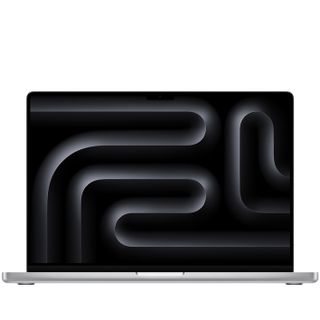
There is no doubting Apple's creative genius in music production, and this is the mobile machine on which to enjoy it to its fullest. The 16" MacBook Pro boasts the best battery life here, and is a Mac that will last years before you think you need an upgrade - not common in Apple circles.
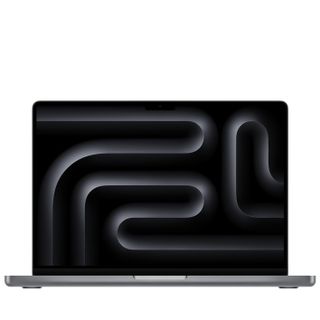
Making use of the newest M3 chips, the 14” MacBook Pro model has enough in the way of processing power and cutting-edge performance to suit even the most demanding of creative professionals, making it the best all-rounder laptop for music production right now.
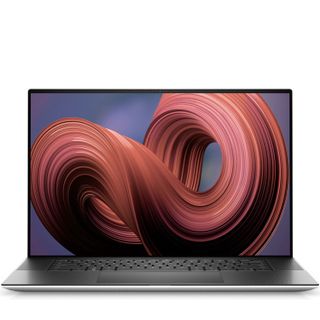
The Dell XPS line has built up a strong reputation thanks to its sleek design, gorgeous screens, and powerful spec. They are billed as the ideal laptops for on-the-go creatives who don’t fancy signing up to the Apple walled garden, and the closest Windows alternative to an Apple MacBook Pro.

The Air M3 is available in two sizes: 13-inch and 15-inch. We much prefer the larger screen size for music making. We carried out several benchmark tests between the Air M2 and this all new M3, and found that in Ableton Live we got a 25% uplift in performance for the M3, rising to 30% in Logic.

Apple's latest Pros and Airs all feature the latest M3 chips, with only this model retaining the M2. But that doesn't mean it is found lacking in the music production department. At just 1.24kg and just 11.3mm deep, the Air M2 is still a beautiful and compact MacBook choice, and the cheapest portable way to get into Mac music making.

For Windows fans, their range of crossover tablet-slash laptops is a powerful option when considering your next music production laptop. The Microsoft Surface Pro 9 is an absolute beast of a machine, perfect for intensive music projects.
Load the next 4 products... ↓
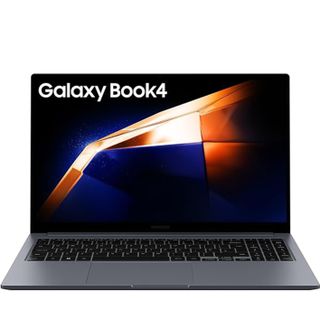
The Samsung Galaxy Book4 Pro gets you a similar look and feel to an Apple MacBook but within the Windows world. Performance wise, it sits around or just above the same benchmarks as the MacBook Air 13" M2.
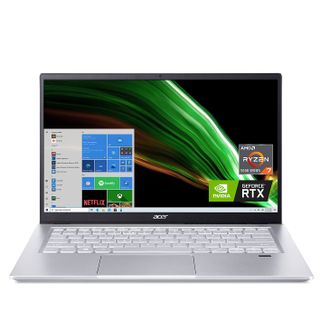
With the Swift X14, Acer has squeezed both a powerful CPU and GPU into a slim Ultrabook form and topped it off with a gorgeous OLED screen. And while it's not quite up there with a MacBook Pro 14" it is among the best Ultrabooks you can get.

With the Razer Blade 15 Studio, however, we have a monstrously powerful laptop with its origins in the gaming world, but with its sights very much set on creative pursuits. It's more than powerful enough to handle CPU-intensive tasks with multiple plugins, and we absolutely love the clarity of the screen.

With an Intel i9 processor and a base spec of 16 GB of RAM, you know this machine can chew through any audio production task you throw at it. Once you get past the garish colour scheme and 'edgy' gamer branding, you have an immensely capable, lightweight computer that would rival many traditional desktop arrangements.
Best overall
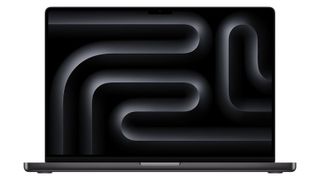
✅ Buy if you want the best of the best and money is no object: Max out one of these beasts and you'll certainly pay for it, but you'll also have the most capable, future-proofed machine on the planet.
❌ Avoid if you want something more down to earth: There are much cheaper and still very capable Apple (and non-Apple) laptops out there.
If you really want to know what the best laptop is for music making in the world right now, you can probably guess it's packed with power, has the Apple logo emblazoned on the top and costs the earth. We'll not get into the Mac v PC battle for laptop music production supremacy here - there are plenty that will argue both sides of the coin for you, and we have more in our buying advice at the end of this guide - but there is no doubting Apple's creative genius in music production. And this is the mobile machine on which to enjoy it to its fullest.
In truth, though, the fully Maxed out MacBook Pro, in this case with the all-new M3 Max processor, is probably - okay certainly - too much for many music tasks. We've rarely pushed our 24GB RAM Air, yet the Max brute starts at 48GB RAM! Similarly you shouldn't really pay the extortionate extra cash for an 8TB storage option when a decent separate fast hard drive will bolster the 1TB bass model for much less outlay.
You can get a cheaper 16" MacBook Pro option with the M3 Pro processor, which with a (approx) 20% price drop over the full-fat M3 Max is also a more sensible offering.
Both 16" Pro models offer a great music production experience with their large 16.2" displays - the biggest screens bar just one model in this round-up - but, really, you are looking at a big price difference, even compared to other Macs here, all for headroom you might not need.
Still, the 16" MacBook Pro boasts the best battery life here, and is a Mac that will last years before you think you need an upgrade - not common in Apple circles - so if anyone is wondering what to buy us for Christmas, we could easily fill that 8TB and 128GB of RAM if you pushed us… So, go on then.
Best all-rounder
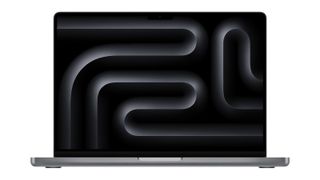
✅ Buy if you want a fantastic Apple laptop that's (a little) more budget-friendly: Apple gear still costs, but even the basic spec M3 MacBook Pro will give you plenty of music-making grunt.
❌ Avoid if you want a lighter laptop: The M3 MacBook Air matches the Pro in performance, but is much lighter and slimmer.
We've included the 16" MacBook Pro as our pick for the most powerful performance laptop in this guide as it is truly the best mobile computer for music production, with the bigger screen size and power you might want (but not necessarily need). But the 14" MacBook Pro represents the cheaper way of getting that mobile power, although you can also spec it up to a price that gets close to the 16", as it too can have the top-end M3 Max processor.
However, if you dig deep into the McBook Pro 14" range - and there is a spec for everyone (and we could have filled this guide with various configurations) - you should be able to find a model that balances both price and power.
At the lowest end of the range you can get a 14" MacBook Pro for well under $/£2,000 with a stanrdard M3 processor, but our tests have shown that the M3 Air has just as much power and a bigger screen - hence it also having a high position in this guide. So really, if the smaller 14" screen is something you are after, you might want to take advantage of the faster M3 Pro or Max processors in this machine, but either way you'll quickly add to the asking price.
The 14" MacBook Pro is a fantastic machine - or indeed many good machines - but you will have to work out which one you need with some care. There's a machine for everyone here, but you might have to do some digging (and maths) to find it.
Best Windows laptop
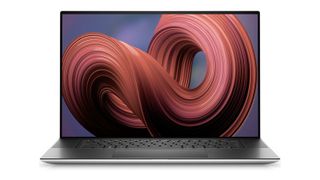
✅ Buy if you want a high-performance Windows machine with a large screen: We've long been fans of Dell laptops for music production and this one delivers fantastic specs and plenty of screen real estate.
❌ Avoid if you want a more compact laptop: Combine the large screen and the relatively bulky chassis and it quickly becomes less appealing as an on-the-go laptop.
Sometimes you can feel restricted using a laptop screen for music production, and that's when you need to call in a machine like the Dell XPS 17. With a huge 17" screen in all configurations, it is easily the biggest laptop here, although that obviously makes it one of the least portable.
Otherwise the XPS 17 (and we looked at the mid range 9730 model, too) is a fantastic laptop. It has an elegant design and enough power to make you consider using it over any desktop machine.
As with many PC laptops, you can greatly configure the specs, but as you can see from the wide price range, this quickly adds up and you can easily find yourself paying around $4,000/£3,500 for those tempting extras.
Whichever option you choose, you get a gorgeous screen, especially with the UHD+ upgrade, and while we have found 13" laptops restrictive for music making, you won't find yourself lacking space on any of the 17" configurations.
The Dell XPS 17 has some serious power. For music, gaming, even a bit of work if you must, this laptop is a match for it all. Bulky compared to some, yes, but you might just not worry about the extra weight when you are immersed in that lovely screen.
Best portable laptop
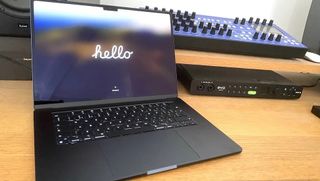
✅ Buy if you mostly make music on the go: The Air is lightweight, comes as a 13" screen variant and has plenty of power under the hood for most tasks.
❌ Avoid if you're on a budget: The M3 Air is still expensive. Instead, we'd recommend the M2 Air which still offers stellar performance for much less outlay.
Apple has now updated all of its laptops to the latest M3 range of chips. Only the Air is also still available with the older M2 processor (see below). The Air M3 on test here is available in two sizes: 13-inch (actually 13.6-inch) and 15-inch (15.3-inch). We much prefer the larger screen size for music making and have found 13" laptops restrictive in the past.
We carried out several benchmark tests between the Air M2 and this all new M3, and found that in Ableton Live we got a 25% uplift in performance for the M3, rising to 30% in Logic, more than even Apple claims! Our sister site TechRadar even suggests that the Air M3's multicore stats are right up there with the entry-level M3 MacBook Pro.
To our mind, the M3 Air is a better buy than that base-model MacBook Pro as it boasts the bigger screen and equal power, but costs less. We also discovered in our tests that the bigger 15" model has a significantly better sound from its own speakers over the 13" Air.
Combine the performance with the quiet Air operation, the sleek design and larger screen, and we think the 15-inch Air M3 is currently one of just two Apple laptops to beat for mobile music production.
Read our full Apple MacBook Air M3 review
Best budget Mac
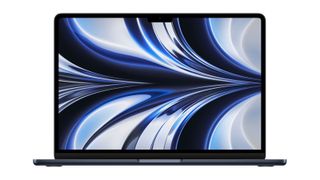
✅ Buy if you don't need the very latest tech: It's slim, lightweight with great battery life, while the M2 chip should serve you through many happy years of music-making.
❌ Avoid if you have a bit more to spend: Upgrading to the M3 model isn't as expensive as you might think.
Apple's latest MacBook Pros and Airs all feature the company's latest M3 chips, with only this model retaining the M2. But that doesn't mean it is found lacking in the music production department.
At just 1.24kg and just 11.3mm deep, the Air M2 is still a fabulously portable option, and its lack of a fan gives it an advantage in the noise stakes when it comes to music making as well.
The battery life of the Air is good, quoted at 18 hours, and more than a match for most PC laptops, and the speaker sound is very good with Spatial Audio support.
The Air M2 is still a beautiful and compact MacBook choice, and the cheapest portable way to get into Mac music making. It still packs a punch for most music tasks, but you might consider the Air M3 if you have the extra cash for a 20-25% uplift in power.
Read our full Apple MacBook Air M2 review
Best 2-in-1 laptop
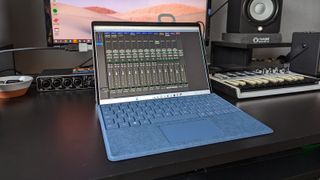
✅ Buy if you prefer a touch screen: This one also doubles as a tablet, so if you want a device that can also serve as your entertainment and work machine, this is definitely one to look at.
❌ Avoid if you don't need a touchscreen: Why pay for something you don't need or want?
For Windows fans, their range of crossover tablet-slash laptops is a powerful option when considering your next music production laptop. The Microsoft Surface Pro 9 is an absolute beast of a machine, coming with a 12th Gen i7 processor, 16GB RAM, and a 256GB SSD drive, making it more than a match for vast music projects on the go or in the studio.
In our tests it performed admirably with a huge ProTools project, running well over 200+ tracks at an ASIO buffer size of 64 before we began to notice any pops and clicks. Compatibility is excellent as well, as at the time of writing there are no known issues with plugins and Windows 11, unlike a certain popular OS.
The screen is stunning thanks to its 120Hz refresh rate, meaning that everything looks incredibly detailed and runs smoothly. It's got ten-point multi-touch capability too, offering some neat features for producers that allow you to quickly make adjustments without having to reach for the mouse. The ability to split it quickly and turn it into a tablet is a great feature in general, whether you're using it for music production or not.
Read the full Microsoft Surface Pro 9 review
Best MacBook-alike

✅ Buy if you like MacBooks but prefer Windows: This is an ideal choice if you want the familiar MacBook aesthetic but prefer working in Windows.
❌ Avoid if you want the real deal: Why buy something that looks like a Mac when you could just get a Mac? If you have the cash, we say go for it.
The Samsung Galaxy Book4 Pro gets you a similar look and feel to an Apple MacBook but within the Windows world. Performance wise, it sits around or just above the same benchmarks as the MacBook Air 13" M2.
The Galaxy Book4 Pro is available in both 14" and 16" models and its OLED screen is a huge highlight with a lovely image quality and 120Hz refresh. It also scores over Apple machines with touch input.
However, compared to the Apple machines its speakers do disappoint - not that we'd recommend using any laptop speakers for detailed mixing - but for general music listening, Apple scores well.
We got 14 hours battery life out of the Samsung which is decent, and overall this is one of the best MacBook alternatives out there.
Best slimline laptop
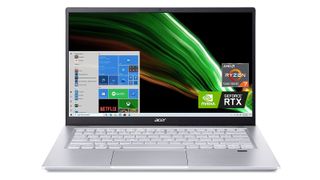
✅ Buy if you want a laptop with a lush screen: The OLED screen nestled in this slim ultrabook is beautiful - ideal for those long, eye-straining Ableton sessions.
❌ Avoid if you want more battery life: You'll only get around 8 hours before you're reaching for the power supply, so not such a mobile-friendly machine.
With the Swift X14, Acer has squeezed both a powerful CPU and GPU into a slim Ultrabook form and topped it off with a gorgeous OLED screen. And while it's not quite up there with a MacBook Pro 14" it is among the best Ultrabooks you can get.
It's not the cheapest machine and the battery life of around eight hours when running at full power is nothing to write home about, but the pros outweigh the cons, especially if you don’t want to lug a heavy laptop around.
The OLED screen is a real star of the show too, and performance wise there’s little the Acer Swift X14 can’t do - it's a small machine that will handle many music tasks, not something you can say about all Ultrabooks.
The Acer Swift X14 is not a cheap machine but that price does make sense if you factor in the power and screen, and we think it is one of the best compact choices for music out there.
Best for gamers
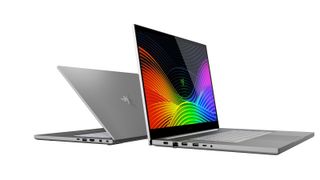
✅ Buy if you want power: Gaming laptops need to be supremely powerful, which is what makes this one such a great option for monster music projects.
❌ Avoid if you're a casual music-maker: All that power could be unnecessary for the majority of hobbyists.
Think of a gaming laptop, and you probably imagine garish colours, RGB lights all over the shop, and enough power under the hood to light up a continent. With the Razer Blade 15 Studio, however, we have a monstrously powerful laptop with its origins in the gaming world, but with its sights very much set on creative pursuits.
Gaming laptops are often powerful enough for music creation as they require beefy CPUs and plenty of RAM to perform. We found the Razer Blade to be more than powerful enough to handle CPU-intensive tasks with multiple plugins, and we absolutely love the clarity of the screen.
There are some nice visual touches, from the customisable RGB backlighting on the keys, but otherwise, this is a strong, slick studio beast that demands attention. It looks professional, so you won't feel out of place when you rock up to the studio with it.
Best for upgrading

✅ Buy if you want a laptop that grows with you: With some upgrade potential, this is a machine that you can enhance as your needs change.
❌ Avoid if looks are important to you: This is the most garish laptop on the list, so unless you like to stand out from the crowd, you'll probably want to look at some of the more understated options.
At the higher end of the gaming PC spectrum - not a bad place for music producers to look when sheer power is required - there are some serious studio contenders. The Asus Rog Strix Scar is evidence of this; with an Intel i9 processor and a base spec of 16 GB of RAM, you know this machine can chew through any audio production task you throw at it.
Hudson Mohawke, the Scottish electronic producer, is a known fan of the Strix range, and with good reason. Once you get past the garish colour scheme and 'edgy' gamer branding, you have an immensely capable, lightweight computer that would rival many traditional desktop arrangements.
Read our full Asus Strix Scar 16 review
Buying advice
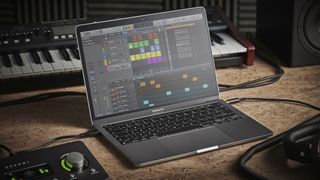
How to choose the best laptop for music production
Choosing a laptop capable of running CPU-intensive audio production work can be tricky. Some options focus heavily on battery life. Others major on performance, and favour higher-grade processors (CPUs) to ensure operations run snappily. Add into that differences in screen sizes, aesthetics, and any number of other variables and we can easily see how it’s hard to justify buying one model over another.
There are certain characteristics you’ll look for in a laptop, regardless of whether it’s for producing music or editing video. Namely, you are looking for that sweet spot of power, performance, and price. We all wish that the last part wasn’t a factor, but it is. Not to worry though, as there are supremely capable laptops coming in at some very sensible prices right now. So what are the specifics that make a great production laptop?
Ultimately, when we say performance, in this context we mean how fast the laptop can process things, and how quickly it can access, write, and modify stored data. If you’re a sample-based producer and have gigabytes of stored loops and one-shots, then you will want to focus on a machine that offers super-snappy access to your stored media. And, while they come in a little bit more expensive than traditional hard disc drives (HDD), the only real option nowadays is a laptop that comes with a solid-state drive (SSD). Solid-state means there are no moving parts - so nothing to go wrong or fail - but with rapid data transfer speeds so you’re not waiting on that pesky progress bar.
Which CPU is best for music production – Intel, AMD or Apple?
Essentially, a faster processor (or CPU) means two things: your computer can handle more tasks being thrown at it, and it can 'process' those things a lot quicker. You may see only small differences; perhaps an audio file will render one minute quicker using the faster of two processors, but over time this clearly adds up.
In the CPU world, there are two major players. Intel is the big name, with a huge share of the market. Intel’s range goes from i3 - the least powerful - all the way up to i9. Most common in mid-to-upper tier laptops, however, are the i5 and i7 variants, and within that sphere you have different speed ratings, measured in gigahertz, as well as the option to turbo-boost when you’re placing the computer under major stress.
With newer machines, you might find the 'i' has been dropped so the range is referred to as Core 3/5/7/9.
The other name to look out for is AMD, which produces the Ryzen processors. These follow a similar nomenclature to the Intel versions, so R3, R5, R9 and so on, and are popular among the gaming crowd.
Apple has a great heritage in producing machines designed for creative pursuits, and just as the rest catch up with them, it flips the script again. You may have seen newer Apple machines with their 'M'-range chips inside them. These essentially combine many of the laptop's internal components onto a single chip, resulting in incredible power and overall system efficiency. Apple’s newest machines feature the M2, M2 Pro, M2 Max, M2 Ultra, M3, M3 Pro and M3 Max chips. We go into more detail on M2 vs M3 Macs in this article.
The good news is that these gains absolutely benefit producers, offering best-in-class performance and processing grunt, while also delivering longer battery life and other optimisations. Put simply, Logic Pro X users on an M3-based machine are at the head of the DAW pack right now. The bad news, however, is that many third-party software brands haven’t yet made the switch required to make the most of it. More are catching on, with big names like Ableton and Akai offering full native support.
The best advice we can give is to do your research - all of the major developers are aware of the new chips, and are likely working on native support, so it depends on your current setup and desire to rock the boat. If you can, and don’t anticipate major problems, then we’d absolutely advise looking at these new breeds of MacBook.
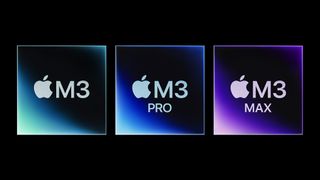
What do I need to know about Apple's new processors?
Until late 2020 Apple computers used Intel processors - the same type that you'll find in most PCs. Since then the company has been introducing its M range of chips, so far the M1 and M2 ranges and the latest M3, M3 Pro and M3 Max (currently available in the latest MacBook Airs and MacBook Pros). These combine both CPU (central processing unit) and GPU (graphical processing unit) on one chip, with each indicated by a number of cores - and the more of these, the better in terms of power.
The base M2 processor has eight or 10 cores each and is found in the Air and Mac Mini with faster M2 processors in the Mac Studio and Mac Pro. The Mac Studio has either an M2 Max (12-core CPU, 30-core GPU) or a maximum M2 Ultra chip that goes up to 24-core CPU and 76-core GPU. The Mac Pro, meanwhile, also has a maximum M2 Ultra chip (up to 24-core CPU and 76-core GPU).
The M3 processor ups the number of cores to a maximum of 16 CPU and 40 GPU and variations of the M3 are found in the iMac, Air, and 14" and 16" MacBook Pros. The variations are the standard M3, M3 Pro and M3 Max.
If all of this talk of M-range processors is baffling, just take away one fact from it. In our tests, the M range outperformed the original Intel Mac processors by at least three to one, so whichever M chip you choose, expect a big power boost over your old Intel Mac.

How much RAM does your music making laptop need?
With RAM, as we mentioned, you can ignore the 'minimum specs' listed on the websites of the major DAWs. Anybody who tries to run a multitrack Ableton Live session on a laptop with 4GB of RAM is braver (or more patient) than we are.
That’s because RAM is effectively the short-term memory of your machine. With audio applications, particularly those involving lots of recorded audio, a higher amount of RAM means your audio playback is buttery smooth and glitch-free because the computer isn't having to 'grab' the audio from the hard drive each time it wants to play.
If you're buying now, with the next few years of use in mind, we'd suggest 8GB of DDR4 memory is the absolute minimum you should be looking for. Ideally, you'd want 16GB, as this will handle much larger arrangements, although there is a cost to this extra resource.
It's also worth investigating whether the laptop you choose can be upgraded with extra RAM in the future. Apple laptop fans won't have this luxury, due to their sealed chassis, but laptop PC users might.
How much storage do I need?
Storage memory comes a close second. For audio applications, particularly those involving sample libraries where audio is streamed from disk, you'll want to use a solid-state drive (SSD). The benefit of these drives is the rapid data transfer, meaning files load quicker, although they are slightly more expensive than their hard disk drive (HDD) equivalent. For music production applications, however, the extra expense is totally justified.
It's not uncommon however to see a combination employed – an HDD for storage of files, photos, and videos, and an SSD for tasks where more instantaneous responses are required. The alternative involves using external hard drives; SSDs, particularly those that take advantage of USB-C technology, are more than capable of the types of transfer speeds required for music production.
Is Mac OS better than windows?
So, we reckon this debate will rage for eternity, with many evangelising the Windows infrastructure, while others remain eternally devoted to Apple. There will always be two camps, but in truth either will serve you well for music making these days.
That said, if money is no object then we would recommend exploring the Apple route - it's no coincidence that four of the top five music production laptops in this guide bear the Apple logo. They just work for music - with killer hardware and audio optimised spec - and as the M-series chips continue to evolve and developers invest in making their software and plugins cooperate, making music on Apple machines will remain firmly ahead of the game.
Of course, not every producer has the budget for Apple and there are so many great Windows alternatives in this guide that will do a similar job for much less, with the added bonus of being able to upgrade hardware like RAM to keep up with the game - a feature that's distinctly lacking on Apple machines.
How we test laptops for music production
So, clearly there is a lot to think about when choosing the best laptop for music production.
It's easy to see why a good all-round laptop can fetch a premium price tag, but, as with anything from the best samplers and studio monitors to home studio mixers, you get what you pay for, so it's always wise to get the best you can afford, rather than skimping and regretting your purchase later (often quicker than you thought). Our price comparison software will come in handy here. Next to each product entry on this guide our price widgets will display the best deals online right now to save you shopping around.
In this guide we don’t focus on various legacy ins and outs, such as the number of USB sockets, or lack of, for your audio interface, and so on. With so many dongle and docking options available, this shouldn’t be a deciding factor in your purchasing journey. In this guide we're talking sheer horsepower for music-making. For example, can your portable rig cope with large multitrack sessions, running handfuls of plugins and MIDI instruments?
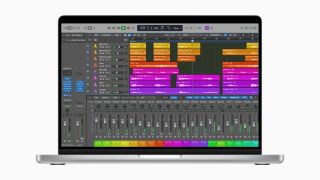
When testing a laptop for music production, we take into account a variety of design aspects, features and power. On a basic level, a music production laptop must be portable and powerful. For the latter consideration, that's why we often include those gaming laptop PCs as they are designed to deliver clout.
Obviously a lightweight design is great, but we also need connections - Thunderbolt, USB-C or even A for older interfaces. Really the more the better, although most Apple laptops now only feature a couple of Thunderbolt 3 ports which you can just about get away with for music.
In terms of power, it is often difficult to compare processors just on their specs as they can work very differently in a real world music production environment. With that in mind, where possible we compare and contrast by using standard DAW projects from the likes of www.logicprohelp.com and www.music-prod.com. Here you simply run the project and add audio tracks until your machine falls over. You then get an idea of the power of a particular processor in a real production scenario.
Finally we'll also look at screen and speaker performances. Certainly Apple excels at these with recent speaker designs that can be (just) used for mixing plus vibrant screens that help you see everything your DAW has to offer.
Read more about how we test music making gear and services at MusicRadar.
Related buyer's guides
MusicRadar's got your back
- Our pick of the best Macs for music production
- Best mouse for music production: mice, trackpads and trackballs
- Check out our guide to the best budget PCs for music production
- Our pick of the best PCs for music production
- Best DJ laptops: PC and Mac options for the booth and beyond
- Organise your recording space with the best studio desks

